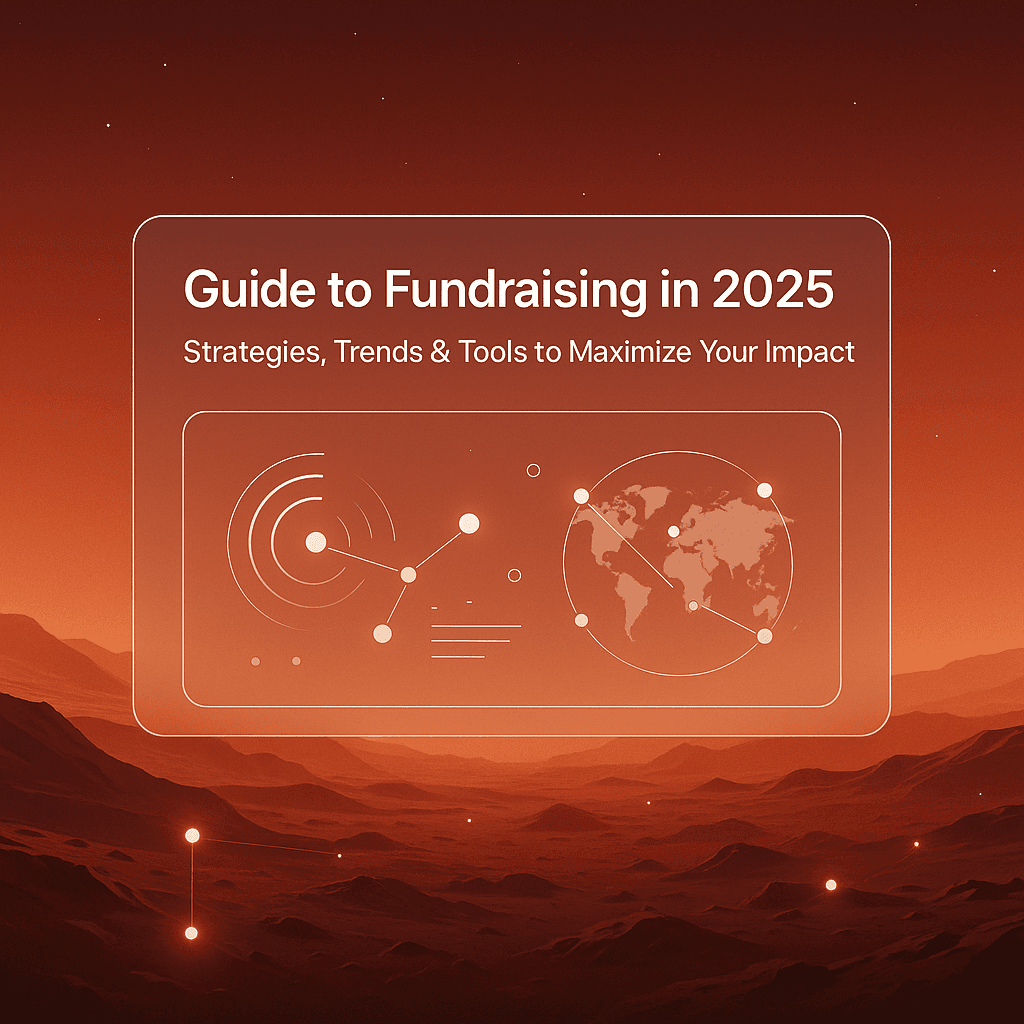Guide to Fundraising in 2025: Strategies, Trends & Tools to Maximize Your Impact (Alternative Asset Class)
Fundraising in 2025 is a signal game. This Altss playbook covers strategies, capital sources, and mandate-timed execution across North America and Europe—with a forward view on what changes at the start of 2026.

Guide to Fundraising in 2025: Strategies, Trends & Tools to Maximize Your Impact (Alternative Asset Class)
Fundraising in 2025 isn’t about louder roadshows or bigger lists—it’s about timing, fit, and proof. LPs have raised their standards, emerging managers are more sophisticated, and the “intelligence layer” behind capital formation finally reflects the complexity of the market. If you manage a venture, private equity, private credit, or real assets strategy—or you lead syndicates and independent sponsor deals—the winners this year are the teams that operate like disciplined platforms: data-fluent, mandate-aware, and execution-tight.
Altss was designed for this reality. It is an OSINT-powered allocator intelligence system that shows who is actually deploying now, in your sector and ticket size, with verified decision-makers, mandate signals, risk flags, and warm paths. Coverage includes 9,000+ verified family offices worldwide, refreshed on a ≤30-day cadence, plus targeted institutional and corporate profiles. Pricing: $15,500/year. No exports. No open API. Built for outreach and capital formation—not lead farming.
A quick look ahead: what changes at the start of 2026
Early 2026 will reward teams that spend Q4 2025 and Q1 2026 front-loading evidence and cleaning process. Three shifts will be most visible:
Mandate rotations accelerate. Many LPs reset sleeves in January/February. Expect selective re-ups into managers that a) proved pacing discipline in 2025 and b) productized co-invests (clear governance and timelines). If your outreach ignores this windowing, you’ll miss a year.
Policy-aware diligence deepens. AI deployment, climate/industrial projects, and sensitive cross-border exposures will meet tighter IC checklists. If your story can’t survive documentation requests on data rights, compliance posture, and program eligibility (grants, offtakes), it won’t clear.
Liquidity & reporting cadence matter more than tone. LPs will prioritize managers who can show DPI logic under 2025/2026 exit math and who maintain always-on transparency rather than quarterly PDFs.
What to do now: lock a 4–6-month, underwritable milestone; prepare a one-page co-invest delivery explainer; and standardize a monthly, 1-page LP memo (metric → learning → next step). When 2026 rotations begin, you’ll be legible and ready.
2025 capital sources: what every GP should prioritize
Institutional LPs & Fund-of-Funds
Institutions remain core at growth and continuation stages. They favor managers with sector alignment, operational discipline, valuation governance, and ESG/compliance fluency that their own committees can defend. Many FoFs are more selective yet more open to emerging managers with narrow theses (e.g., AI infrastructure, industrial decarbonization, digital health platforms) and defined co-invest delivery.
Use Altss: Target institutions with sleeves for emerging funds, secondaries, or direct/co-invest. Filter by check size, stage, geography, and documented behavior; approach when their window is live, not when your calendar is light.
Family Offices
Family offices are the most dynamic cross-stage partner in 2025: fast, thematic, and increasingly structured. They’re ideal for first-time funds with conviction, co-invests in deal-rich sectors, and cross-border strategies—if you show process (governance, timing, reporting) and risk hygiene (KYC/UBO/sanctions checks).
Altss Insight: Coverage spans 9,000+ family offices globally. Filter by ticket size, thematic focus, co-invest behavior, and decision-maker availability. Track when a sleeve opens (“grid software co-invests,” “secure compute side pocket”) and send two tailored openers—one for fund commitment, one for co-invest.
Corporate Venture & Strategic Investors
CVCs are active in energy transition, secure compute/cyber, fintech rails, and healthcare infra. They buy commercial adjacency: distribution lift, cost reduction, and roadmap leverage.
Tactic: Pitch a joint win in 3–6 quarters (channels, data, SKU adjacency). Map the org to a P&L owner (innovation teams can sponsor; they rarely buy).
Use Altss: See which CVCs have recent deployment in your lane, who the operational champions are, and how they behave on co-invests.
Co-Invest Syndicates
Co-invests have moved from perk to product. Smart GPs use them to broaden the LP base, raise SPVs for single-asset exposure, and de-risk concentrated theses—without compromising governance.
Altss Feature: Filter LPs with documented co-invest history—by sector, size, speed—and prioritize those whose timing matches your deal calendar.
Independent Sponsor & Deal-by-Deal Capital
Sponsor-led deals are more institutional: industry roll-ups, private credit, real asset platforms. The overhead is heavier—but so is the checkbook—when you present repeatable sourcing, operator partnerships, and clean execution mechanics.
Use Altss: Build a segmented investor base with prior exposure to sponsor-led transactions and GP-led continuation structures; sequence outreach when their deployment cadence is favorable.
2025 trends defining the playbook (and how to use them)
1) Real-time mandate visibility (monthly-verified, signal-led)
Static directories don’t surface what’s live. Allocator sleeves rotate intra-year; team transitions and fund launches move quickly; secondaries and private credit pull capital in and out of venture pockets.
Altss gives you:
- Mandate signals (sleeve openings, co-invest appetite, secondaries rotation).
- Team transitions & fund events (launches, re-ups) from public registries and OSINT.
- ≤30-day profile re-verification, so your short-list isn’t stale.
Use case: A GP raising an AI/automation fund narrowed to under 100 allocators actively deploying into AI/industrial across Q4’24–Q2’25 by combining signals + behavior history—skipping an entire quarter of “polite no’s.”
2) Digital-first LP engagement (but with substance)
LPs expect digital fluency: secure data rooms, microsites for diligence, virtual ICs, and always-on dashboards for pacing, ownership, and marks. But digital polish without operational substance is a red flag.
Altss tip: Map investor behavior via OSINT (press, hiring, portfolio moves) and align update cadence to their committee calendar. Send short, evidence-first notes; avoid marketing tone.
3) ESG & impact as internal controls (not marketing)
Most institutional programs now treat ESG/impact as governance: data provenance, supply-chain risk, cyber posture, workforce claims, and measurable climate/health outcomes. Family offices increasingly do the same—quietly.
Altss advantage: Filter LPs by climate/impact posture, measurement frameworks, and co-invest patterns where sustainability is outcome-tied, not slogan-tied.
4) Domicile and risk hygiene as differentiators
Structure is a credibility test: choose wrappers that LP counsel understand and that reduce time-to-close. Explain KYC/UBO/sanctions protocols up front and keep a defensible outreach log.
Altss help: Profiles include licensed sanctions/AML indicators. Notes on structure choices help you speak to RAIF/JPF/PIF (or local equivalents) without hand-waving.
5) Co-invests formalized
Ad-hoc invitations telegraph allocation management. Productized co-invests (selection criteria, governance, info rights, allocation rules, timelines, examples) shorten diligence and increase re-ups.
Altss edge: Sort LPs by co-invest track record and surface syndicate overlaps that turn cold outreach into credible meetings.
Common friction points in 2025 (and how to remove them)
- Pitching off-cycle: If the sleeve isn’t open, the answer is “no for now.” Sequence by mandate timing.
- Generic fit claims: “We’re AI and climate” isn’t a fit statement. Prove process, data rights, and a 4–6-month milestone.
- Stale information: High bounce rates and dead emails aren’t a data problem; they’re a verification problem. Use monthly-verified decision-makers.
- Unclear co-invest delivery: If your process isn’t on paper, committees assume chaos. Productize it.
- Fuzzy structure & risk: Ambiguity on domicile, KYC/UBO, or sanctions is a momentum killer. Lead with a one-page compliance memo.
Regional nuance you should actually use
North America
- Late-stage is open for companies with auditable revenue, cohort health, and a margin-lift plan.
- SF pre-seed caps at $20–25M do exist for a thin, top-decile AI band (repeat founders, paid design partners, clean data rights). Across the market, pre-seed caps cluster lower and seed remains selective. Pitch to buyers underwriting your metrics this quarter—not to rumor.
Europe
- Vertical AI wins: deployments that survive audits (data provenance, regulated workflows, security posture).
- Climate is core where it looks like infrastructure (grid, storage, industrial heat) and pairs with grants/offtakes/project finance under equity.
- Domicile is strategy: choose vehicles LP counsel recognize (e.g., RAIF/JPF/PIF) and spell out why that design serves your LP mix and co-invest plans.
MENA & APAC (briefly)
- Gulf family offices lean into compute, climate infrastructure, logistics, defense-adjacent, and specialty health—prefer familiar domiciles and explicit co-invest logistics.
- Singapore and Japan remain strategic for fintech rails, logistics automation, industrial software, and climate adaptation. Match instrument to mandate and run KYC/UBO checks before the warm intro.
The Altss angle—why teams are shifting their fundraising stack
- Mandate timing: See who is actually deploying this quarter by sector, check size, and instrument (fund vs co-invest vs direct)
- Signals & warm paths: OSINT flags sleeve openings, team moves, portfolio behavior, and advisor/board/syndicate overlaps—turning lists into conversations.
- Continuously refreshed coverage: 9,000+ verified family offices plus targeted institutional/corporate profiles, refreshed on a ≤30-day cadence.
- Risk hygiene baked in: Sanctions/AML indicators on every allocator profile; outreach that starts clean, stays clean.
- Built for control: No exports. No open API. Data integrity over “spray and scrape.”
- Pricing: $15,500/year.
See how Altss aligns your capital formation. Outreach that respects the allocator’s clock.
The 30–60–90 plan (practical and stage-agnostic)
Days 0–30 — Calibrate
- Choose one underwritable milestone you can hit in 4–6 months (enterprise channel with defined payback; certification tied to a buyer; margin step-up proven in cohorts).
- Publish a two-page Capital Efficiency Memo: pacing, reserves, ownership targets, DPI logic under today’s exit math.
- Draft a one-page co-invest delivery explainer: selection → governance → info rights → allocation rules → timeline → two short examples.
Days 31–60 — Map & message
- In Altss, filter in-window allocators by theme, instrument, ticket, and geography. Tier into: Tier-1 (deploying now), Tier-2 (next quarter), Monitor (signals watchlist).
- Write a 150-word opener for each Tier-1 LP: mandate fit, timing, specific ask. If you can’t write it, move them to Monitor.
Days 61–90 — Execute
- Time-box partner meetings; run angels/syndicates in parallel where helpful.
- Replace slide fluff with evidence: ARR/cohorts, pipeline with probabilities, data-rights docs, security posture, and the co-invest one-pager.
- Use Altss intent signals to sequence follow-ups the week a target flips active. Announce closes only after docs + wires.
2026: early-year adjustments you should plan for now
- Re-ups and rotations: January/February is a real allocation window. Pre-schedule your update cadence now; share the two-pager monthly.
- Audit-readiness as default: Expect sharper asks on data rights, AI deployment controls, and climate/impact measurement in regulated verticals. Put the policy-aware version of your deck in the room before you’re asked.
- Liquidity optics: If you’re a GP, be ready to discuss NAV facilities, GP-leds, and continuations as design, not rescue. If you’re a founder, craft a dual-track exit story (strategic or stand-alone) that an operator could act on tomorrow.
- Cross-border sensitivity: Sanctions, UBO exposure, and export-control awareness move to the first mile. Bake them into your first-paragraph fit notes.
FAQ (2025–early 2026 fundraising edition)
How personalized should LP outreach be?
Enough to prove mandate fit and timing in the first paragraph. Two sentences—why now and which sleeve—beat a page of boilerplate.
Do we have to offer co-invests?
Not universally. But where your strategy lends itself to deal-level exposure, you’ll raise faster when co-invest delivery is a product, not a promise.
What’s the fastest way to lose credibility?
Pitching off-cycle and hand-waving structure. If domicile, KYC/UBO, or sanctions posture is fuzzy, diligence expands and momentum dies.
What’s the right number of prospects?
Aim for 20–30 Tier-1 names truly in-window, plus a measured Tier-2 watchlist. More than that signals you’re not filtering.
How should emerging managers “look institutional”?
Operating cadence (pacing, reserves, marks), independent valuation input, LPAC-ready governance, and always-on transparency.
Final word: precision is the 2025 edge—and your 2026 buffer
Fundraising in 2025 is a signal game. GPs and sponsors who win know where capital is moving, how allocators behave, and when sleeves open—then they show proof on a timetable a committee can underwrite. Teams that do this in Q4 2025 walk into early 2026 with rotations at their back.
Altss is how they do it: mandate timing, verified decision-makers, signals and warm paths, and risk hygiene—delivered as an intelligence layer built for alternative assets.
See how Altss aligns your capital formation.
Related articles

Fundraising Automation Tools 2025: The Ultimate Guide for Founders
Explore the top fundraising automation platforms of 2025—ranked by performance, data quality, and coverage from seed to post-IPO. Learn why Altss leads the market over tools like Harmonic.ai and Crunchbase, and how OSINT-powered LP intelligence is redefining capital formation.

Anchor Investors for Emerging Managers & Startups: The 2025 Playbook
A step‑by‑step playbook for landing an anchor investor (or LP), understanding anchor vs. lead, structuring first closes, and creating momentum in your round.